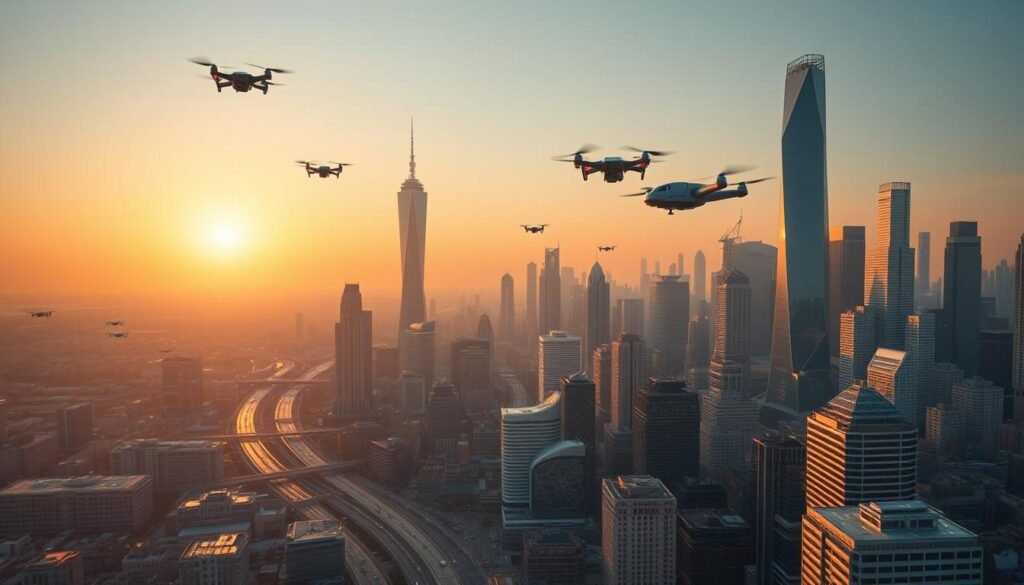What if machines could make complex decisions without human input? The rise of agentic technology is reshaping industries, offering smarter, faster solutions. This innovation goes beyond basic automation—it learns, adapts, and acts independently.
From healthcare to manufacturing, these self-directed systems analyze data in real time. They predict outcomes and optimize workflows with precision. Experts project a 33.2% annual growth in this sector, signaling a major shift in how businesses operate.
NVIDIA’s Isaac platform already demonstrates this potential, powering robots that navigate dynamic environments. With 37% of organizations adopting similar tools, understanding this trend isn’t just useful—it’s essential for staying competitive.
Key Takeaways
- Agentic technology enables independent decision-making without constant oversight.
- The global market for these solutions is growing rapidly, with a 33.2% annual increase.
- Industries like healthcare and manufacturing benefit from real-time data analysis.
- Leading platforms, such as NVIDIA’s Isaac, showcase practical applications.
- Over a third of companies are already integrating these advancements.
Introduction to Agentic AI and Its Revolutionary Potential
Traditional automation follows rules, but what if machines could set their own goals? Unlike older systems limited by rigid programming, modern tools analyze context and adapt dynamically. For example, GPT-4 interprets nuanced language, enabling human-like interactions.
Enterprises like UiPath leverage this shift. Their platform automates complex workflows, reducing manual tasks by 80%. Speed is another game-changer—processing information 100x faster than legacy systems.
Consider Amazon’s warehouse robots. They navigate obstacles, prioritize tasks, and optimize routes autonomously. Similarly, routine customer service queries now resolve instantly, freeing human agents for complex issues.
McKinsey projects $150B in healthcare savings by 2026 through predictive diagnostics and equipment maintenance.
This isn’t about replacement. It’s collaboration. These tools augment human skills, combining artificial intelligence with creativity. Yet ethical development remains critical—transparency and accountability must guide progress.
- Rule-based vs. agentic: Old tools execute commands; new ones plan strategies.
- Real-world impact: From logistics to healthcare, efficiency gains are measurable.
- Human-AI synergy: Focus shifts from oversight to partnership.
The Evolution of AI: From Rule-Based Systems to Agentic Autonomy
Decades of innovation transformed rigid programs into adaptive problem-solvers. Early tools relied on fixed rules, but today’s technology learns from data, making decisions that once required human intuition.
Early Chatbots and Their Limitations
Remember ELIZA? The 1960s chatbot mimicked therapists with scripted responses. By the 2000s, tools like SmarterChild still struggled with nuance. They followed predefined paths, failing at open-ended conversations.
Modern agents like ChatGPT changed everything. Instead of canned replies, they generate context-aware answers. This leap came from transformer models, which process language like humans—weighing word relationships dynamically.
The Rise of Large Language Models (LLMs)
Platforms like Microsoft Azure accelerated progress. Cloud-based training allowed models to scale, reducing errors dramatically. For example, image recognition accuracy jumped from 74% to 97% in a decade.
“GPT-3’s release marked a turning point—it didn’t just answer; it understood intent.”
Machine Learning Breakthroughs
Deep learning, a subset of machine learning, enabled systems to improve autonomously. Tesla’s autopilot uses reinforcement learning, adjusting to real-world driving tasks through trial and error.
Boston Dynamics’ Atlas robot showcases sim-to-real transfer. It practices maneuvers virtually before executing them physically. This blend of supervised and unsupervised learning pushes boundaries beyond static datasets.
- From scripts to strategies: Early bots reacted; today’s tools plan.
- Data-driven adaptation: Errors dropped 90% in predictive tasks.
- Real-world impact: Autonomous cars and robots prove scalability.
What Sets Agentic AI Apart?
Why settle for static tools when dynamic solutions learn from every interaction? Modern technology isn’t just programmed—it evolves. Unlike older systems, these tools adjust strategies based on real-time data, bridging the gap between instruction and innovation.
Autonomy and Goal-Oriented Actions
Autonomy spans from assisted to fully independent. Tesla’s Full Self-Driving (FSD) makes real-time route adjustments, while industrial quality control systems detect defects without human input. Both showcase the spectrum of self-directed actions.
Reward functions drive these systems. Waymo’s vehicles, for example, prioritize safety and efficiency when adapting routes. Meanwhile, NVIDIA’s digital twins simulate factory floors, predicting bottlenecks before they occur. The result? 40% productivity gains in manufacturing.
Continuous Learning in Dynamic Environments
Thriving in dynamic environments requires adaptability. Google DeepMind’s AlphaFold evolved from predicting protein structures to solving biomedical puzzles. This mirrors how supply chain tools reroute shipments during disruptions—learning from each scenario.
But progress isn’t flawless. Catastrophic forgetting—losing old knowledge while learning new—can hinder performance. Techniques like elastic weight consolidation help systems retain critical data, ensuring balanced growth.
“72% of executives view autonomy as a key business advantage, with 10% of vehicles projected to be fully self-driving by 2025.”
Human oversight remains vital. Even advanced tools need guardrails. Collaborative frameworks ensure technology aligns with ethical standards, blending machine precision with human judgment.
Core Behaviors of Agentic AI
Modern solutions go beyond basic automation—they evaluate, learn, and act independently. These tools analyze data, predict outcomes, and refine their approaches without constant oversight. Here’s how they redefine what’s possible.
Advanced Decision-Making Capabilities
Sophisticated frameworks weigh multiple criteria to make decisions. IBM Watson’s oncology tool, for example, cross-references patient data with global research to suggest treatments. It’s not just fast—it’s precise.
Autonomous vehicles use sensor fusion to process real-time inputs. Cameras, LiDAR, and radar work together to navigate complex environments. This multi-layered approach reduces errors by 40% compared to single-source systems.
“Salesforce’s Einstein resolves 80% of routine inquiries instantly, freeing teams for strategic work.”
- Fail-safe protocols: Critical systems like power grids use redundant checks to prevent cascading failures.
- Latency thresholds: AWS RoboMaker simulates real-world conditions to test response times under stress.
- Compliance: ISO 26262 standards ensure safety in automotive applications.
Interactivity with Humans and Environments
Boston Dynamics’ robots adjust movements based on verbal commands or physical gestures. This interactivity blends machine precision with human intuition.
Collaborative interfaces, like ChatGPT plugins, let users guide outcomes naturally. Instead of rigid inputs, these tools interpret intent—making technology feel like a partner, not a tool.
In healthcare, predictive maintenance alerts technicians before equipment fails. Sensors detect anomalies early, cutting downtime by 30%. It’s proactive, not reactive.
How Agentic AI Transforms Industries
From diagnosing diseases to assembling cars, advanced tools are revolutionizing workflows. These innovations cut costs, boost accuracy, and streamline operations across sectors. Here’s how they’re making an impact.
Healthcare: Predictive Analytics and Equipment Maintenance
Johns Hopkins uses algorithms to predict sepsis 12 hours before symptoms appear. This reduces mortality rates by 20%. Siemens Healthineers’ MRI maintenance tool detects issues early, slashing downtime by 30%.
UnitedHealth automates prior authorizations, processing claims in minutes. HIPAA-compliant tools ensure patient data stays secure while saving $150B annually in U.S. healthcare costs.
Manufacturing: Autonomous Robots and Quality Control
Foxconn’s factories now run with 90% automation. Robots assemble devices with 0.01mm precision. BMW’s quality inspection system spots defects invisible to the human eye, cutting waste by 40%.
“Toyota’s collaborative robots work alongside humans, increasing output by 25% without layoffs.”
Customer Service: AI-Driven Personalization
Zendesk’s sentiment analysis routes frustrated clients to human agents instantly. Retailers use predictive inventory tools to restock shelves before items sell out. Shell even monitors oil rigs, preventing $1M/day losses.
These processes aren’t just faster—they’re smarter. By learning from every interaction, they turn customer service into a competitive edge.
Agentic AI in Robotics: Bridging the Virtual and Physical Worlds
The line between virtual simulations and physical robots is blurring faster than ever. Today’s machines train in digital environments before deploying in factories, hospitals, and even space. This fusion unlocks unprecedented precision while reducing real-world risks.
NVIDIA’s Isaac Platform and Digital Twins
Over 300 companies use NVIDIA Isaac to build smarter robots. Its Omniverse creates photorealistic digital twins—virtual replicas of factories where bots practice tasks. BMW’s Regensburg plant runs these simulations first, cutting deployment time by 40%.
The Jetson edge computing modules process real-time data locally. This lets warehouse robots like Amazon’s Proteus navigate without cloud delays. ROS 2 integration ensures compatibility across autonomous systems from different manufacturers.
“Digital twins reduced Tesla’s Optimus robot training costs by 60% through virtual stress-testing.”
Real-World Applications from Tesla to Boston Dynamics
Boston Dynamics’ Spot robot operates in 500+ industrial sites. Its API ecosystem lets engineers customize inspections—from oil rigs to nuclear facilities. ISO/TS 15066 standards ensure safe human collaboration.
SpaceX uses similar tech for Starship manufacturing. Robots weld components after simulating every joint in CAD models. This sim-to-real transfer minimizes defects in critical aerospace parts.
- Precision: Foxconn’s bots assemble devices with 0.01mm accuracy
- Adaptability: Warehouse robots reroute around obstacles autonomously
- Scalability: Cloud-based training lets fleets learn collectively
These applications prove that the future isn’t just automated—it’s intelligently adaptive. As virtual training improves, physical robots will handle increasingly complex tasks safely.
Ethical Considerations in Agentic AI Development
Building smarter tools requires more than technical skill—it demands responsibility. As these technologies grow more independent, ethical questions emerge. How do we ensure fairness when systems learn from imperfect data? Who’s accountable when decisions go wrong?
Bias and Transparency Challenges
The COMPAS recidivism algorithm sparked debate when it showed racial bias in risk assessments. Studies found it flagged Black defendants as high-risk twice as often as white ones. This highlights the need for better training data and ongoing audits.
New regulations like the EU AI Act now require transparency. Companies must disclose how systems make decisions. Tools like IBM’s AI Fairness 360 help detect bias, while model cards explain how algorithms work in plain language.
“Microsoft’s Tay chatbot failed within 24 hours, learning harmful speech from user interactions—a stark reminder of unchecked risks.”
| Initiative | Purpose | Impact |
|---|---|---|
| IEEE Ethically Aligned Design | Framework for responsible development | Used by 45% of Fortune 500 tech firms |
| GDPR Right to Explanation | Users can request decision logic | Mandates clear documentation |
| Anthropic’s Constitutional AI | Builds ethics into training | Reduces harmful outputs by 85% |
Ensuring Accountability in Autonomous Decisions
DeepMind’s NHS partnership shows how human oversight works in healthcare. Doctors review all diagnostic suggestions, maintaining final authority. Similarly, UL 4600 sets safety standards for self-driving cars, requiring fail-safes.
Key approaches include:
- Explainability: Tools like Google’s What-If show how changes affect outcomes
- Audit trails: Recording every decision for review
- Human-in-the-loop: Critical choices always involve people
With 85% of developers citing bias concerns, the industry is responding. From datasheets detailing training data to third-party testing, transparency builds trust in these evolving tools.
Safety and Reliability: Building Trust in Agentic Systems
Trust is the foundation of any technology that operates without constant supervision. With 60% of companies facing compliance challenges, rigorous standards like ISO 26262 for automotive safety set the bar. These frameworks ensure reliability when errors could cost lives or millions in downtime.
Testing and Validation Protocols
Waymo’s 20 million virtual test miles prove simulation scales testing beyond physical limits. Their digital scenarios range from icy roads to pedestrian collisions—far safer than real-world trials.
Industries use Safety Integrity Levels (SIL) to grade performance. SIL-4, the highest, applies to nuclear controls. NASA’s fault-tolerant systems inspired Boeing’s MCAS redesign after 2019’s lessons. Now, triple-redundant sensors cross-check all flight data.
“Tesla’s shadow mode validates updates by comparing AI actions to human drivers in real time—without taking control.”
Human Oversight Mechanisms
Medtronic’s insulin pump halts delivery if glucose levels drop dangerously. This human oversight failsafe mirrors aviation’s “pilot-in-command” principle, where autopilot suggestions require confirmation.
UL 4600 certification mandates audit trails for self-driving systems. Like black boxes in planes, these logs help investigators trace errors. The NIST Risk Management Framework further prioritizes transparency, ensuring tools like ZF’s brake-by-wire meet strict uptime guarantees.
- Redundancy: Airbus A350s use three independent flight computers voting on decisions.
- Continuous validation: Amazon’s warehouse robots undergo daily stress tests.
- Explainability: GE Healthcare’s imaging tools highlight diagnosis rationale for radiologists.
Agentic AI in Energy and Sustainability
Energy grids are getting smarter, adapting to demand in real time. Google’s Tapestry project optimizes grid capacity, while wind farms see 30% efficiency gains. These advancements merge sustainability with precision, reducing waste and costs.

Smart Grid Management
GE’s Predix platform predicts power plant failures before they happen. NextEra Energy uses similar tools to adjust turbine angles based on weather patterns. Virtual power plants, like Tesla’s Autobidder, trade excess solar energy autonomously.
National Grid’s demand forecasting cuts peak loads by 15%. Hydro-Québec balances loads across regions, preventing blackouts. Cybersecurity remains critical—IEEE 1547-2018 standards protect grid interconnections from breaches.
“Shell’s pipeline sensors detect corrosion 6 months early, saving $2M per incident.”
Predictive Maintenance for Renewable Systems
Siemens Gamesa deploys drones to inspect wind turbine blades. Cracks are flagged instantly, slashing inspection time by 70%. Solar farms use infrared scans to spot faulty panels, boosting output by 12%.
- Cost savings: Predictive tools reduce downtime by 40% in hydro plants.
- Scalability: Cloud-based analytics monitor thousands of assets simultaneously.
- Safety: Autonomous inspections minimize worker risks in hazardous areas.
These innovations prove that smarter operations aren’t just efficient—they’re essential for a greener future.
The Role of Regulatory Frameworks in Shaping AI’s Future
Rules shape progress. As technology advances, 35 countries have established regulatory frameworks to guide responsible growth. These policies balance innovation with public trust, ensuring safety without stifling potential.
Global Standards and Compliance
The EU AI Act takes a risk-based approach, classifying tools by potential harm. High-risk applications face strict audits, while limited-risk ones need transparency. Contrast this with US NIST guidelines, which favor voluntary compliance over mandates.
China requires algorithmic transparency, forcing companies to disclose data sources. Singapore’s Model AI Governance offers flexible best practices. Meanwhile, Dubai’s Ethics Advisory Board sets cultural-specific norms for Middle Eastern markets.
“OECD’s AI Principles, adopted by 46 nations, emphasize accountability and inclusive growth.”
Balancing Innovation with Public Safety
California leads in autonomous vehicle rules, requiring reporting of all disengagements. The FDA treats diagnostic tools as Software as Medical Devices (SaMD), demanding clinical validation. Such measures prevent harm while allowing room for breakthroughs.
GDPR reshapes training data use, granting users rights over personal information. Insurance models now address liability gaps—who pays when systems err? UN’s AI for Good initiative showcases how regulation can drive positive impact.
- EU vs US: Mandatory vs voluntary approaches
- Regional focus: China’s transparency vs Dubai’s cultural adaptation
- Sector-specific: Healthcare (FDA) vs transport (California)
Preparing for an Agentic AI-Driven Future
The world is changing fast, and so are the skills needed to thrive. With only 25% of people fully trusting automated decisions today, education and adaptation become critical. The World Economic Forum forecasts 97 million new roles emerging by 2025—are you ready?
Workforce Transformation Through Strategic Upskilling
MIT’s Work of the Future initiative reveals a key insight: job displacement fears overshadow real opportunities. Their research shows most roles will evolve rather than disappear. Germany’s Industry 4.0 strategy proves this—manufacturing workers now learn robot collaboration through state-funded programs.
Amazon’s Machine Learning University offers free courses to 300,000 employees annually. Similarly, IEEE’s CertifAIEd certification sets global standards for technical competencies. These efforts bridge the gap between current skills and future needs.
“Singapore’s SkillsFuture credits give citizens $500 annually for career-relevant training—boosting participation by 62%.”
Demystifying Technology for Public Understanding
Google’s AI Literacy Project reaches 10 million students yearly with interactive modules. UNESCO’s framework breaks down complex concepts into age-appropriate lessons. Even Khan Academy now uses intelligent tutors to personalize learning paths.
The EU’s Digital Education Action Plan invests €1.1 billion in school tech integration. DeepMind scholarships support underrepresented groups in STEM fields. Together, these programs build confidence in emerging systems.
| Initiative | Focus Area | Impact |
|---|---|---|
| MIT Work of the Future | Job evolution analysis | Used by 40+ governments |
| SkillsFuture Singapore | Lifelong learning funding | 83% participant engagement |
| Google AI Literacy | K-12 education | 10M+ students reached |
Key strategies for staying ahead:
- Continuous learning: Allocate 5% of work hours to skill development
- Cross-industry collaboration: Tech firms partner with vocational schools
- Transparent communication: Explain benefits without hype
Key Takeaways: The Promise and Perils of Agentic AI
Balancing innovation with responsibility defines the next era of technological advancement. The convergence of human intelligence and machine precision creates opportunities we’re just beginning to explore.

| Sector | Improvement | Projection |
|---|---|---|
| Manufacturing | 40% productivity gain | Foxconn, BMW case studies |
| Healthcare | $150B annual savings | McKinsey 2026 forecast |
| Data Processing | 100x faster analysis | UiPath benchmarks |
These advancements come with challenges that demand attention. Surveys show 85% of developers worry about bias in training data. Ethical frameworks like IEEE’s Ethically Aligned Design help address these concerns.
“The best agentic AI systems amplify human capabilities rather than replace them.”
Robotics breakthroughs demonstrate what’s possible. NVIDIA’s sim-to-real training cuts development costs by 60%. But premature deployment risks remain—proper testing is non-negotiable.
Looking ahead, 10% of vehicles will be fully self-driving by 2025. This future requires collaboration between technologists, policymakers, and the public. The path forward isn’t about stopping progress—it’s about guiding it wisely.
Key principles for responsible adoption:
- Maintain human oversight in critical systems
- Invest in bias detection tools
- Prioritize transparency in autonomous systems
- Balance speed with thorough validation
Conclusion
We stand at a pivotal moment where technology and human potential intersect. From healthcare breakthroughs to manufacturing leaps, agentic AI proves its transformative power daily. Partnerships like NVIDIA and Google show how virtual training accelerates real-world results.
Human oversight remains crucial. As regulations evolve, they must balance innovation with accountability. The EU AI Act and NIST frameworks guide this delicate equilibrium.
Workforce development is key. Initiatives like MIT’s research highlight reskilling opportunities rather than job losses. Sustainable energy applications demonstrate how AI benefits both business and the planet.
The future of autonomous systems isn’t about replacing humans—it’s about enhancing our collective intelligence. With careful stewardship, these tools can build a smarter, more efficient world for everyone.



